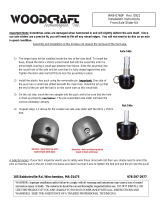
8 HGM-H
all parts must be kept free of foreign material
and chemicals.
Protect all exposed sealing surfaces and open
cavities from damage and foreign material. The
external surfaces should be cleaned before
beginning any repairs. Do not use a pressure
washer to clean the transaxle.
FLUIDS
The uids used in Hydro-Gear products have
been carefully selected, and only equiva-
lent, or better products should be substituted
Typically, an engine oil with a minimum rating
of 9.0 cSt (55 SUS) at 230°F (110° C) and an
API classication of SL is recommended. Refer
to the vehicle manufacturer for recommended
oil.
FLUID VOLUME AND LEVEL
Certain situations may require additional uid
to be added or even replaced. In addition to
lling the hydraulic system with uid, an
additional 34 . oz. (1000mL) will need to be
added to the case via the highest ll point
of the HGM-H unit. Reference page 4 for
the proper ll location. Refer to the vehicle
manufacturer’s recommendations for the proper
ll location and level of the complete hydraulic
system. After maintenance or oil change, follow
purging procedures on page 9 and check the
uid level once the unit has been purged and
operated for 1 minute.
FLUID CHANGE
In the event of oil contamination or
degradation, oil addition or change may
alleviate certain performance problems. Refer
to the vehicle manufacturer’s recommended
oil change frequency. Refer to purging
procedures on page 9 after changing uids.
FILTERS
An inlet lter is required to insure that only clean
uid enter the system. Refer to the vehicle
manufacturer for approved lter replacement.
SERVICE AND MAINTENANCE
EXTERNAL MAINTENANCE
Regular external maintenance of the hydraulic
motor should include the following:
1. Check the vehicle operator’s manual for the
recommended load ratings. Insure that the
current application does not exceed load
rating.
2. Check reservoir oil level in accordance with
the vehicle manufacturers recommenda-
tions.
3. Inspect the vehicle drive belt, idler pulley(s),
and idler spring(s). Insure that no belt slip-
page can occur. Slippage can cause low
input speed to the pump resulting in low
ow to the hydraulic motor.
4. Inspect the vehicle control linkage to the
directional control arm on the vehicles pump
assembly.
5. Inspect the hydraulic motors and pumps
for debris. Keeping the units debris free is
important in the overall performance of the
unit.
6. Inspect all external plumbing for possible
leaks or loose ttings. An air leak may be
difcult to detect on the “suction side” or inlet
line to the pump. Refer to Purging Proce-
dure on page 9.
SERVICE AND MAINTENANCE
PROCEDURES
Some of the service procedures presented on
the following pages can be performed while the
transaxle is mounted on the vehicle. Any repair
procedures as mentioned in the repair section
of this manual must be performed after the unit
has been removed from the vehicle.
Cleanliness is a primary means of assuring
satisfactory life on repaired units. Thoroughly
clean all exposed surfaces prior to any type
of maintenance. Cleaning of all parts by us-
ing a solvent wash and air drying is usually
adequate. As with any precision equipment,























